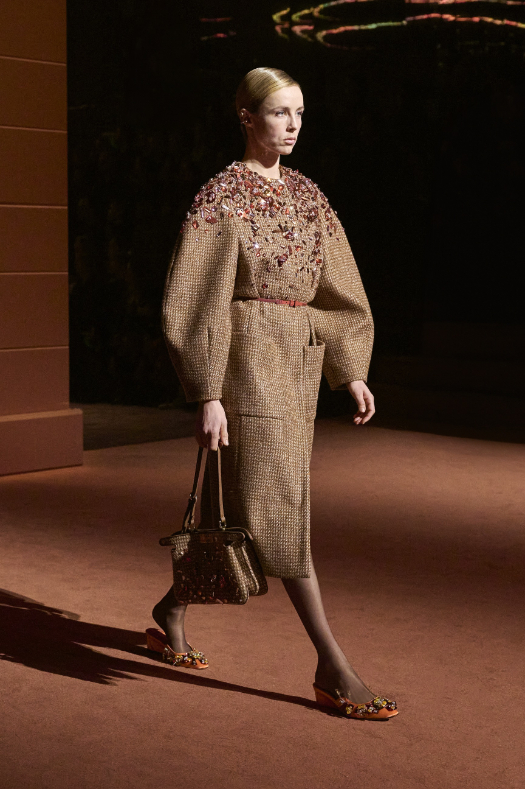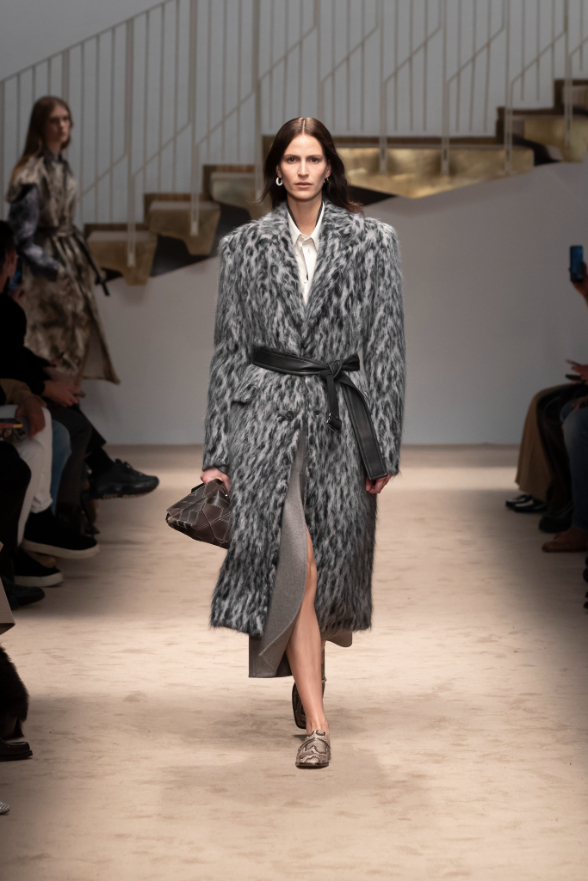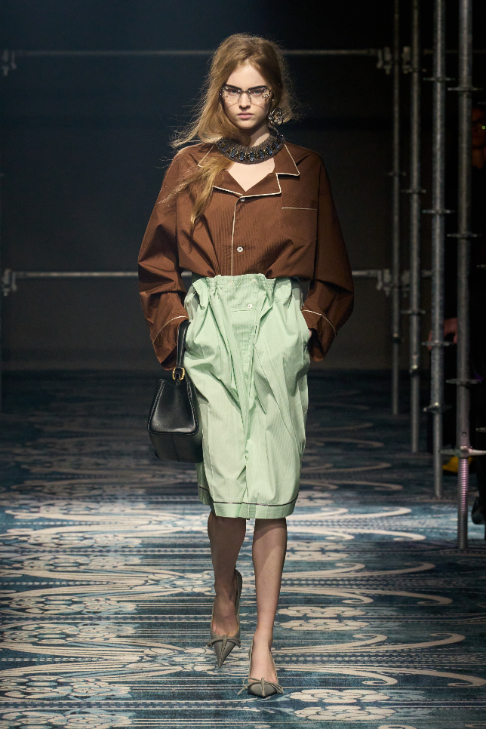
Fashion is a constantly shifting industry but this season felt even more unsettled than usual. Gucci and Fendi were both between creative directors. Acquisition rumours swirled around Versace—though that is still up in the air, it was later confirmed after the show that Donatella Versace would be stepping down with Miu Miu’s Dario Vitale assuming her role. Luke and Lucie Meier were to depart Jil Sander after a strong 8-year run. Simone Bellotti would show his last collection for Bally and then replace the Meiers. Bottega Veneta was a no-show as Louise Trotter prepped for her September debut. Even then, there were bright spots. Fendi celebrated a monumental milestone with an appropriately dazzling show, Donatella went out on a high, and Miuccia Prada and Raf Simons proved once again that they have their fingers on the pulse like no one else.
Related article: Cohesion And Character At Gucci Even Without A Creative Director
FENDI
It was fitting that the collection meant to celebrate 100 years of Fendi was designed by Silvia Venturini Fendi. After all, who would understand Fendi-ness more than a Fendi herself? The designer has capably filled this role before, after Karl Lagerfeld’s death and before Kim Jones’ appointment. In his three years at the brand, Jones has sometimes struggled to clearly define the Fendi woman. Venturini Fendi faced no such problem. The epic 86-look co-ed collection she presented felt indelibly Fendi and Roman—it was grand but it wasn’t precious; and it nodded to the past in a way that felt light and assured, and decidedly not retro.
Related article: The Runway Rundown: Milan Fashion Week Ends On A Sartorial High
Venturini Fendi did away with grand overarching themes or archival deep dives, and instead focused on clothes that felt as beautiful as they looked. Tailoring and outerwear were constructed to be both structured and soft at the same time—think long swingy coats with larged turned-up collars, or cinched wool jackets with curved leather sleeves. Elsewhere, there were soft suede button-ups worn with slightly flounced below-the-knee leather skirts, rhinestones scattered on serious-looking tweeds and herringbone wools, fuzzy knits in the warm gradient hues of a Roman sunset, and glossy eelskin dresses. One pleated dress was made to look like crumpled cardboard—which sounded a lot chicer than it sounds. To counter all that chicness, Venturini Fendi added a dose of playfulness via colourful oversized beanies with built-in veils and bag charms in the form of giant dolls, borrowed from the Fendi children’s line.
Related article: Miu Miu Was Cool-Girl Catnip
VERSACE
While the audience didn’t know it at the time of watching the show, this turned out to be Donatella Versace’s last collection as creative director of the brand her late brother founded, and that she has steered since his death in 1997. In hindsight, it was no surprise then that she doubled down on all the things that Gianni loved and made Versace, Versace—va-va-voom silhouettes that turned women into warrior-goddesses, and bold prints that exuded look-at-me energy. Home is where the heart is and Donatella took it literally this season. Versace was one of the first brands to turn fashion into a lifestyle, as well as one of the earliest to launch a homeware brand. Her starting point was thus Versace Home, opening with a trio of duvets fashioned into a little robe, a mini pouf dress, and a dramatic ball gown. Then came sleek black looks that bared plenty of skin, prints of the Baroque and animal variety, the tiniest tiered dresses in jewel tones, crystal mesh and chainmail numbers, and finally, another showstopping trio—black velvet mini-crini dresses, their hems sculpted in gravity-defying ways to reveal Barocco-printed undersides.
DOLCE&GABBANA
If there’s any brand in Milan that knows how to have a good time, it’s Dolce&Gabbana. While most other Italian labels traffic in prim and proper Italian chic, Domenico Dolce and Stefano Gabbana have always been about a heart-racing kind of hedonism. After last season’s tribute to Madonna and her 90s-defining cone bra, the designers brought it back to contemporary territory for fall/winter 2025 with a collection titled Cool Girls. And the best way to celebrate cool girls the world over was obviously a daytime rave. Outside the brand’s HQ where the show took place was an elevated public-facing platform where a DJ spinned and the models danced. The collection itself was filled with the kind of pieces that make up an It-girl’s wardrobe—big faux furs and little lingerie pieces, cargos and khakis alongside crystals and fringe. In short, the high-low, hot-cool mix that really captured how young women dress today.
SPORTMAX
Since its founding in 1969, the Italian brand has always reflected the dynamism of its time. This season, it explored the idea of hyper-reinvention—making the ordinary, extraordinary. This mostly translated into familiar items rendered new again through materiality and construction. Fringe—both in fine strands and thick bands—sprouted from dresses, coats, gloves and bags. Outerwear came with built-in shawls or thick mufflers for collars. Skirts and jackets had hems that loop back on themselves, or flowed languidly around the body. Zip parkas were cut short in front and extra-long behind. Leather was made to look like python, and jacquard like fur. Casual gear like hoodies and gym shorts got elevated in buttery leather. The more pared back pieces were equally attractive, from suits in sharply tailored dark denim to a handsome, oversized three-piece pinstriped suit.
TOD’S
Milan Fashion Week is filled with labels that try to pin down what Italian chic looks like these days. Tod’s is one of those that can be counted on to deliver on that count every time. This season, Matteo Tamburini refined his ready-to-wear offering even further, serving up true staples —fuss-free, impeccably crafted pieces that will be worn over and over. There were some truly terrific outerwear, including the long, lean coats that opened the show, one in snow-leopard printed mohair, as well as those with flowing asymmetrical blanket capes attached to them.
The simpler fare stood out too—there were crisply tailored shirts and trousers in gorgeous colour pairings such as sky blue with burgundy, or olive green and hunter green worn with accessories in mustard and red. Far from being ascetic, there was softness and warmth to Tamburini’s brand of minimalism. Textures were subtle but delicious—a couple of looks combined suede, silk and snakeskin to stunning effect. Other highlights include slim ankle-grazing wool dresses with raw edges; fuzzy tunics and jackets with thick, fringed scarf collars; and the finale pair of drop-waist dresses that melded super-thin knit with leather.
FERRAGAMO
This season, Maximilian Davis was inspired by dance, but not in the cliched sense of tutus and ballet flats—instead, he was more interested in the body in movement, and how clothing moves with it. This led to a series of knit bodysuits and dresses that clung to the body. Some of them were semi-sheer; others were thick, with collars that extended way past the ears. Occasionally, they were worn under enveloping, structured coats and jackets—and some of those even had an extra layer of protection in the form of soft shearling wraps.
The key accessory of the season were giant double pouches slung on belts around the waist. Sometimes, they came off a tad unwieldy but at other times they looked absolutely chic, as when worn over a leather shirt and leather maxi skirt in two different shades of rich brown; or when they were turned into oversized pockets on a leather coat-dress and a leather bomber. Davis’ strength is that he can hit maximum impact with just the barest of ingredients—see the gray wool coat with the exaggerated scarf collar, tightly cinched at the waist to create a cocoon-skirt effect; or the red leather tulip skirt worn with a white poet’s blouse and a sweeping black coat; or the chocolate silk dress with a thick band of feathers running down one side.
PRADA
Last season’s Prada collection was a push back against the algorithm—its sameness and predictability. For fall/winter 2025, Miuccia Prada and Raf Simons were pushing against preconceived notions of beauty and femininity. What does it mean—and looks like—to “dress like a woman” against the backdrop of today’s fragmented yet information-overloaded world? There was a primal attitude underlining the clothes—a roughness in the way things were gathered, or hacked, pulled askew or apart. Coats seemed haphazardly cut up into dresses and skirts. There were skirts with baggy paperbag-waists that jutted out awkwardly, costume jewels pasted onto knit chokers.
The collection also subverted feminine archetypes, like the LBD or the pretty printed dress. The opening looks were black dresses but loose, blocky shifts—defiantly frumpy. Later, Prada and Simons showed them again in searing bright colours and matronly flower prints. Other dresses looked, in shape, like midcentury couture, but they were chunky knits, worn with jeans and loafers. Fake furs (actually shearling) and leathers were used in a manner that seemed more animalistic than glamorous. Tailoring came with permanent crumples and creases. Seams were exposed and edges left unfinished. The rawness of these gestures and imperfections made for clothes that were so much more compelling.






































































